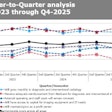Full-time academic radiology faculty salaries show persistent inequities, with women earning less than their male counterparts and Black faculty less than their white peers, researchers have reported.
The findings confirm that salary discrepancies "should be addressed as part of a broader drive to increase diversity, equity, and inclusion," wrote a team led by Ajay Malhotra, MD, of Yale School of Medicine in New Haven, CT. The results were published October 1 in Radiology.
There's no doubt that radiology is confronted with particular challenges now as the healthcare field continues to grapple with high workloads, a physician shortage, and high rates of burnout. For radiologists, these larger problems are compounded by a rising demand for imaging services and shorter report turnaround times. In this environment, it's even more crucial to attract and retain a diverse workforce, and "ensuring salary equity is fundamental to cultivating comprehensive equity within professional practices," the group noted.
The investigators explored the current state of academic radiology compensation using financial data from the Association of American Medical Colleges (AAMC) Faculty Salary Report between 2017 and 2023. The report gathers information for full-time faculty at U.S. medical schools, stratifying it by rank, gender, race/ethnicity, and geography and by median, 25th, and 75th percentile compensation values for each rank. Malhotra's team used the report's median compensation values to compare groups by gender, race and ethnicity, and geographic region.
For 2023, the report data included responses from 5,847 faculty members across all radiology departments. These responses included 306 instructors, 2,758 assistant professors, 1,409 associate professors, 1,004 full professors, 226 chiefs, and 144 chairs.
The researchers found salary discrepancies between men and women and between Black faculty and their white colleagues:
- On average, median faculty compensation increased by 2.6% to 4.4% per year from 2017 to 2023, with the greatest increase (4.4%) at the instructor level and smaller increases (2.6% to 3.4%) at more senior ranks.
- Male faculty members were consistently compensated more than women at all ranks throughout the study period.
- The overall salary gap between women and men held at 6% ($455,000 for women vs. $483,000 for men) throughout the study period but increased from $24,000 in 2019 to $28,000 in 2023.
- Black faculty had a lower median compensation compared with white faculty (by 4% overall; $452,000 for Black faculty vs. $472,000 for white faculty) at all ranks except at the professor level.
- Instructor salaries in the Northeast were higher by $278,000 compared with other regions, but this difference did not exceed $35,000 at other ranks.
| Trends in median compensation for full-time academic radiology faculty, 2017 and 2023 | |||
|---|---|---|---|
| Department position | 2017 | 2023 | Average increase per year, 2017 to 2023 |
| Instructor | $288,000 | $370,000 | 4.4% |
| Assistant professor | $362,000 | $443,000 | 3.4% |
| Associate professor | $401,000 | $492,000 | 3.5% |
| Professor | $433,000 | $514,000 | 2.9% |
| Section chief | $446,000 | $535,000 | 3.1% |
| Chair | $694,000 | $808,000 | 2.6% |
"The increase in median faculty compensation has barely kept pace with the U.S. inflation, which averaged 3.69% per year between 2017 and 2023," the group noted.
Addressing gaps in salaries in academic radiology is a key step toward making the department healthier, according to the researchers.
"Making salaries equitable can be an important first step toward an overall approach to diversity, equity, and inclusion," they concluded.
The complete study can be found here.



















